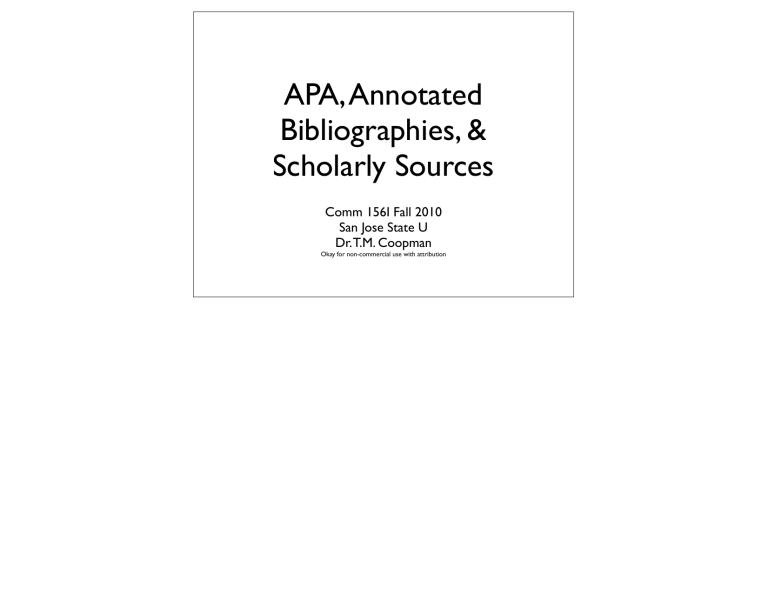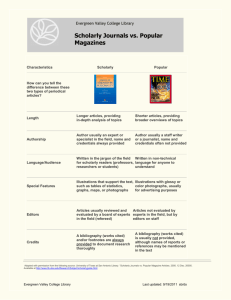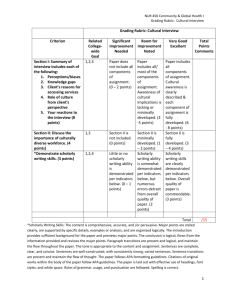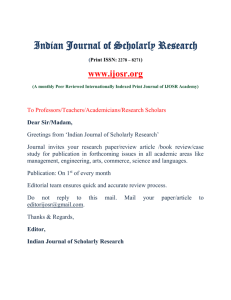APA, Annotated Bibliographies, & Scholarly Sources

APA, Annotated
Bibliographies, &
Scholarly Sources
Comm 156I Fall 2010
San Jose State U
Dr. T.M. Coopman
Okay for non-commercial use with attribution
This Workshop
This is the online component of a research skill workshop. Combined with the in class component, this workshop provides an overview and information references that supply critical knowledge to help you succeed in this course.
This workshop covers using APA, writing annotated bibliographies, and identifying scholarly sources.
Highlights from the
American Psychological
Association Style Guide
We use the APA style guide to ensure accurate and consistent referencing and writing. You will be assessed on your competency in using APA. These examples cover the some of the most common issues and rules for this course and are NOT definitive or complete.
See the wiki for links to APA guides and resources.
Referencing in APA
Title of article is in lower case, except for the first word, first word after a colon, and proper nouns or synonyms
Author’s last name and first and second initial year of publication
Graham, E. S., Domke, D., Coe, K., John, S. L., & Coopman, T. M. (2006). Follow the leader: The Bush administration, new media, and the U.S.A. Patriot Act. Political
Communication 23, 291-312 .
Proper nouns and Synonyms are capitalized
Journal titles are in italics and capitalized
Volume numbers are simply written as a number in italics
Page number ranges are simply written as numbers
Here is an example of a journal article reference that you would use in a Reference list or with an annotated bibliography
Referencing
For this course, you should include information that makes it easy to 5ind the articles you use. You can do this either by including the DOI# or a permanent link as provided by the database. If you retrieve the article for an open access online journal, then you reference the url.
Graham, E. S., Domke, D., Coe, K., John, S. L., & Coopman, T. M. (2006). Follow the leader: The Bush administration, new media, and the U.S.A. Patriot Act.
Political Communication 23, 291-312 .
DOI: 10.1080/10584600600808844
OR
Graham, E. S., Domke, D., Coe, K., John, S. L., & Coopman, T. M. (2006). Follow the leader: The Bush administration, new media, and the U.S.A. Patriot Act.
Political Communication 23, 291-312 .
http://libaccess.sjlibrary.org/login?url=http://search.ebscohost.com/login.aspx?
direct=true&db=ufh&AN=21939061&loginpage=Login.asp&site=ehost-live
Open Online Source
Coopman, T. M. (2000). Hardware handshake: Listserv forms backbone of national free radio network. American Communication Journal, 3.
Retrieved on February 1,
2010 from: http://acjournal.org/
How to Cite APA Inline
It is important to correctly reference other’s work in your own. Here are two examples of how to cite a reference. You do not need to always quote a source, you may simply paraphrase or attribute information to that source.
Use only the author(s) last name.
Citing an article (just the year of publication is needed):
Within the framework of the segmental perspective and hierarchical grounded theory in website design, the GOP and Democrat websites are organized in an almost identical manner (Djonov, 2007).
Year of publication
Author’s last name
Quotes must have the exact location of the quote, either a page if it is provided or a location if it is an online only source:
Using a quote with page #:
Rosselli and Stankiewicz (2008) claim that empirical research shows that media imagery contributes to the
“trivialization of sexual violence” (p.
581).
Page number
” comes after last word or quote Page number is simply: p.
Citations go inside of punctuation
Online quotes without page numbers require a location based on the nearest heading and the number of the paragraph (abbreviated as “para”). So if the quote is in the second paragraph of the Discussion section, it would cited as:
Rosselli and Stankiewicz (2008) claim that empirical research shows that media imagery contributes to the
“trivialization of sexual violence” (Discussion, Para 3).
How to Cite APA Inline
How to cite multiple (3 or more) authors.
The 6irst time you need to list all authors:
(Graham, Domke, Coe, John, & Coopman, 2006) or
Graham, Domke, Coe, John, and Coopman (2006) argue that...
The second time you can truncate:
(Graham et al, 2006) or
Graham et al (2006) argue that...
How to Cite APA Inline
It is okay to group citations as long as they are contiguous.
Before:
Semiotics is the process of placing meaning to images and was used to analyze many advertisements in the aforementioned magazines (Vasallo, 2008). It is the process of analyzing a word and images that represent that word (Vasallo, 2008).
The word that is the focus of this research paper is sexuality. The two magazines, one men’s interest the other being women’s interest, provided many representations of sexuality.
After:
Semiotics is the process of placing meaning to images and was used to analyze many advertisements in the aforementioned magazines. It is the process of analyzing a word and images that represent that word (Vasallo, 2008). The word that is the focus of this research paper is sexuality. The two magazines, one men’s interest the other being women’s interest, provided many representations of sexuality.
Quoting
Quotes cannot stand alone, but must be part of a sentence.
Incorrect:
“Ads promise to create the feelings they represent, thus the act of buying represents consuming the referent emotion. In this sense, all ads are signs with an ideology that is transparent”( Lambiase & Reichert, 2004, p. 100).
Instead:
Lambiase & Reichert (2004) argue “ads promise to create the feelings they represent, thus the act of buying represents consuming the referent emotion. In this sense, all ads are signs with an ideology that is transparent”(p. 100).
Use quotes sparingly. Only quote when it is particularly well written, pithy, or concise. Do not quote mundane information, paraphrase it.
Incorrect:
Borchers (2005) explains that clutter is referred to “as the amount of time devoted to non-program content” (p.366).
Instead:
Clutter is the amount of time dedicated to non-program content (Borchers, 2005).
Common Pitfalls
Confusing reference literature and the data you collect
The literature is scholarly or other reference materials. These are cited and quoted. This is from a journal article
Within the framework of the segmental perspective and hierarchical grounded theory in website design, the GOP and Democrat websites are organized in an almost identical manner (Djonov, 2007).
Data is the information you collect through observation or from non- scholarly sources such as newspapers. You do not have to cite your data, but you should reference its source. This is from an interview the student recorded.
Kenge stated, “We got drafted and pulled in, you know they took all the Japanese and we were put into camps as soon as the war opened.”
Even though this is a quote - it has not page or location reference because it is not from the literature, it is data.
Annotated
Bibliographies
A guide for creating annotated bibliographies(AB) for this course
What is an Annotated
Bibliography?
A bibliography is a list of sources (books, journals, websites, periodicals, etc.) one has used for researching a topic. Bibliographies are sometimes called "references" or "works cited" depending on the style format you are using. A bibliography usually just includes the bibliographic information
(i.e., the author, title, publisher, etc.).
An annotation is a summary and/or evaluation.
An annotated bibliography is NOT an abstract. The abstract provided for most journal articles by the author(s) should NEVER be used as an annotated bibliography.
There are many ways to write an annotated bibliography. For this course, it is a brief description of the source and how it applies to you speciCic project.
An annotated bibliography is useful because it allows the reader to quickly understand what the article is about and how it relates to the assignment.
Organizing an AB
Keep your sentences short . If you have more than one comma, make two sentences. This is not an essay -‐ you are delivering information . Simply refer to the authors by their last name or as the author(s). You do not need to cite with the year, since we know what the article is. Avoid quotes.
Follow a consistent outline for each annotation. For example:
•One sentence about what the article is about.
•What the authors did.
•How it applies to your study (method, topic, theory, background, etc).
•What is/are the major takeaway(s).
For this course, an AB should be about 150-‐160 words MAX.
You do not need to explain your topic in each annotation. If it is not obvious, just address how the author(s) address your topic. Then explain how and why.
Sample AB
Research Question: What is the impact of the Internet on social movements?
Coopman, T. M. (2000). Hardware handshake: Listserv forms backbone of national free radio network. American Communication Journal, 3.
Retrieved on
February 1, 2010 from: http://acjournal.org/
Coopman examines the use of the internet and related technologies by the micro radio movement to organize and share resources. The micro radio movements goal was to "free the airwaves" and allow low power FM radio broadcasting by communities. This broadcasting was illegal and was conducted as "electronic civil disobedience." The author argues the success of the movement was largely due to the introduction of the web during the 1990s.
Websites helped to spread the word of the movement's goals. Of particular interest is how the activists used these new technologies to share very scarce resources such as technical and legal knowledge and give mutual aid in the form of cash and equipment. They mainly used email and listservs. This illustrates how a movement with no of6icial leadership and little 6inancial backing can organize across large distances, attract diverse participants, and succeed even against powerful, well-‐organized, and resource rich opponents.
Scholarly Sources
How to identify scholarly sources and appropriate sources for this course
Please see the links on the wiki for tutorial videos on finding scholarly sources
What is a Scholarly Source?
For general purposes, a scholarly source is one that has been "peer reviewed." The peer review process is the standard way academic research is vetted to ensure that it is accurate and conforms with the accepted norms of whatever the particular discipline or 6ield the research is in. These norms can vary based on variety of factors, which while important to scholars, is beyond the scope of what most students need to know.
The peer review process involves several steps.
First , a paper is submitted to a publication. The author removes all references to her/himself so the reviewers won’t know who wrote the paper. This is known as “blind peer review.” While not all scholarly publications use blind review, it is considered the standard. The purpose of a blind review is to reduce any bias or “pre-‐judging” based on the identity of the author. This can include negative bias, such as personal con6licts, the dislike or lack of respect of a particular 6ield, discipline, or institution, even gender, racial, or political bias. Conversely, positive bias can occur such as the desire to help students or junior faculty get published or personally knowing the author or sharing some af6iliation, or giving the bene6it of the doubt to well-‐known or respected authors. It must be said that there are strong norms in academe against letting bias in6luence the review process. These controls are primarily to blunt unintentional predispositions for or against an author. I would add that this process also protects the reviewer who may fear retribution from a more powerful or in6luential researcher, may not want to damage a collegial relationship with a fellow faculty member, or be tempted to curry favor.
Ultimately, the idea is that a paper is judged purely on its own merits.
Second , the editor decides to either accept the paper and send it out to the reviewers who are experts in the subject matter or reject it. Papers are rejected prior to peer review for many reasons, but the most common is that the topics do not 6it in with the journal's subject, methodological, or theoretical focus. If it is accepted, it is sent out to be reviewed.
Third , the reviewers make comments on the research and recommend to accept the article “as is” (very rare), accept it with revisions that they suggest, or reject it. This information is then relayed back to the author. The author then decides if she/he wishes to resubmit it after making the requested changes.
Usually, authors elect to make some changes and reject others. This process can repeat itself several times before it is published.
Scholarly vs. General
Sources
Most sources are not scholarly. This does not mean that they are inaccurate, bias, or wrong. It just means that they do not have the level of controls to ensure accuracy. Most publications have editors that decide what gets published, who gets to publish, and where in a publication it goes.
Editors know who the author is and there may be a variety of factors that in5luence the decision of what gets published. Moreover, most general publications are funded by advertisers who have their own ideas of what material and perspectives are appropriate. An editor who ignores the wishes of those who pay the bills does so at his/her own peril.
Again, there are many publications that are held in very high regard and in some cases, due to the long lag times between research and publication for scholarly journals, general publications (also known as trade publications) have more up-‐to-‐date information. Moreover, scholarly publications have their own bias issues that can effect content.
The difference is the control mechanisms that are in place to ensure accuracy.
Identifying Scholarly Sources
There are some basic ways to identify if a source is scholarly.
First , the most obvious source for scholarly/peer-‐reviewed material is journals that are sponsored by academic organizations. In Communication, these include the National Communication Association (NCA) and the International
Communication Associations (ICA). Most academic organizations do not produce their own publications but contract with Sage and other commercial publishers to publish them.
It is important to note that just because a periodical is listed in NexisLexis,
Proquest, or other research databases or is called a journal DOES NOT mean it is peer reviewed!
The easiest way to check if a periodical is peer reviewed is to use Ulrich's
Periodicals Directory (databases under “U”) . Put in the publications (not the articles) exact title. Under “publication type” it will tell you if it is “peer reviewed” or “scholarly” (OK) or “trade” or “magazine” (not OK).
Finally, if it comes down to (as it often does) whether or not you get credit for the scholarly source, ask either a librarian or the instructor if a particular item is actually scholarly/peer reviewed.
Finding Scholarly Sources
DO NOT USE GOOGLE: Using a standard search engine is the fastest way to wind-‐up with unacceptable sources.
Use the library databases , that is what they are there for.
First , if you know the name of the journal you are looking for you can simply plug it into the library search engine (see the wiki for a sample list of communication journals).
Second , you can go the the SJSU Research Topics Page and search under
"Communication Studies." You can also 6ind communication related journals under RTVF. To get to all the Comm databases you may select "Communication
Studies Cross Research."
Third , you can use other databases that you may 6ind useful such as JSTOR,
PsychINFO.
Finally, do not be shy about asking a librarian for help (online or in-‐person). In most cases, you can come away with every article you need after one visit.
Acceptable Sources
For this course I expect you to rely on peer reviewed academic journals as your main source of literature. These are easy to 6ind in full text versions and for me to verify.
Scholarly books or edited volumes may be used with instructor pre- approval (I must see physical book or submit pdf of entire text). The reason for this is that abbreviated versions and samples are readily available via Google Books/Scholar. You need to have access to the entire text to understand and use it as a source.
I will not accept:
Conference papers
Book reviews, speeches, editorials in scholarly journals
Articles from academic or university websites
Textbooks
When in doubt, send me the citation!





